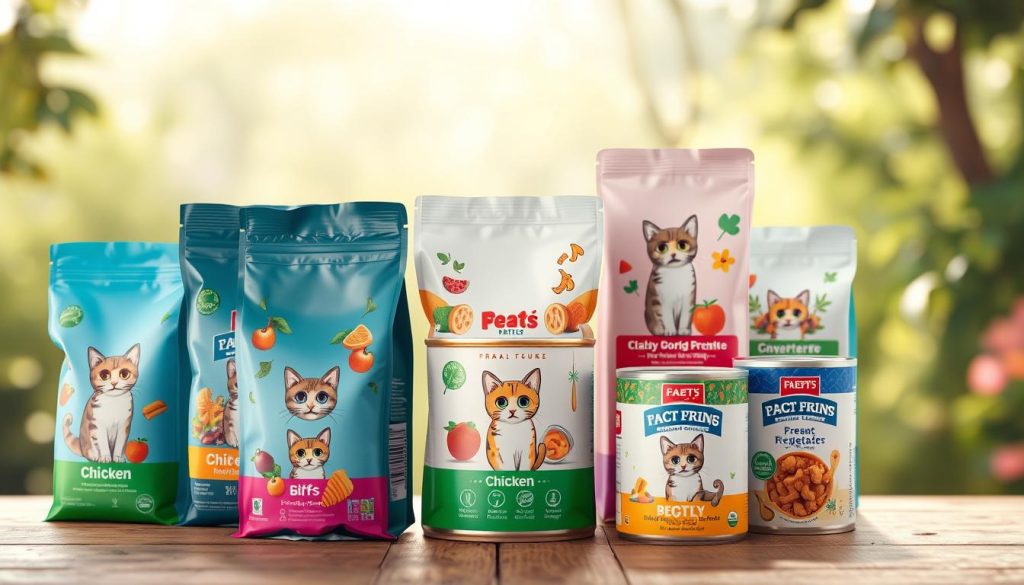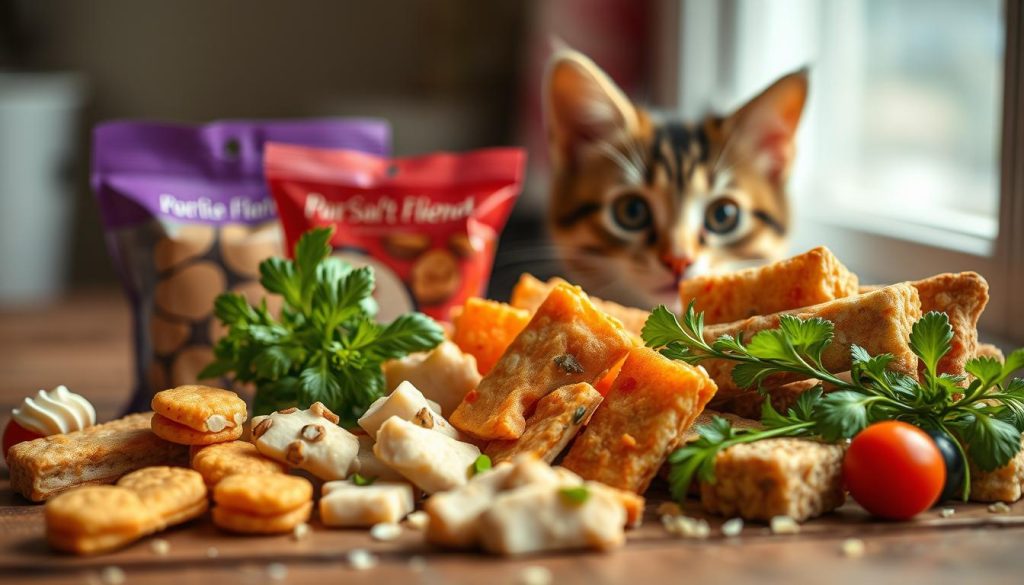As a devoted cat owner, I know how crucial it is to feed my cat right. This guide will share the secrets to a healthy, happy cat. Whether you’re new to pet ownership or want to improve your cat’s diet, this article has you covered.
Cats need a diet rich in animal proteins because they are obligate carnivores. A balanced diet is key to keeping your cat energetic and healthy. We’ll explore the essential components of a cat’s diet and offer tips for a balanced mealtime.
Understanding Your Cat’s Dietary Needs
Cats are different from other pets because they need animal protein. This is key for their health and energy. They get important amino acids from meat, which is vital for them.
Carnivorous by Nature: The Importance of Animal Protein
Cats are true carnivores, needing a diet rich in animal protein. This protein is essential for their growth, muscle health, and overall well-being. Without enough animal protein, cats can get sick, losing muscle and having poor fur.
Balancing Macronutrients: Carbs, Fats, and Proteins
Cats also need the right balance of carbs, fats, and proteins. While they can use carbs, their main energy source should be fats and proteins. Choosing the right cat food is key to meeting their dietary needs.
| Macronutrient | Recommended Range for Cats |
|---|---|
| Protein | 30-50% of total energy intake |
| Fat | 20-40% of total energy intake |
| Carbohydrates | 0-20% of total energy intake |
Knowing about cat dietary needs, cat protein requirements, and macronutrients for cats helps you make better choices. This ensures your cat stays healthy and happy for years to come.
Decoding Cat Food Labels

Understanding cat food labels can seem hard, but it’s key for your cat’s health. We’ll explore how to read and understand cat food labels. This includes understanding cat food labels, cat food ingredients, and cat food nutritional information.
Start by checking the ingredient list on the label. Look for animal-based proteins like chicken, turkey, or fish. These should be the main ingredients. Avoid foods with plant-based proteins like corn or wheat, as they may not be right for your cat.
The nutritional information panel is also important. Check the percentages of protein, fat, and carbs, and the calorie count. Your cat’s food should have at least 30% protein, with some healthy fats and not too many carbs.
- Examine the ingredient list for high-quality, animal-based proteins
- Look for a protein content of at least 30% on the nutritional information panel
- Ensure the cat food has moderate amounts of healthy fats and limited carbohydrates
Don’t trust everything on cat food packaging. Look beyond the marketing to the real nutritional content. By understanding cat food labels, you can choose the best food for your cat’s health.
Wet vs. Dry Food: Which is Better?
Choosing between wet cat food and dry cat food can be hard. Both have their own benefits. The right choice depends on your cat’s needs and likes. Let’s look at the good and bad of each to help you decide.
The Benefits of Wet Food
Wet cat food, or canned food, has many advantages. It has more moisture, which is great for cats that get dehydrated or have urinary problems. This extra water helps keep your cat healthy and hydrated. Also, cats love the taste and texture of wet food, which is similar to their natural prey.
The Pros and Cons of Dry Kibble
Dry cat food, or kibble, is popular for its convenience and long shelf-life. It helps keep your cat’s teeth clean by reducing tartar and plaque. Plus, it’s cheaper than wet food. But, it might not keep your cat as hydrated as wet food, and some cats don’t like it as much.
| Wet Cat Food | Dry Cat Food |
|---|---|
| Higher moisture content, supporting hydration | Helps maintain dental health by reducing tartar and plaque |
| More palatable and appealing to cats | Generally more cost-effective |
| Can be beneficial for cats prone to dehydration or urinary issues | Longer shelf-life for convenience |
The choice between wet and dry cat food depends on your cat’s needs and likes. Always talk to your vet to find the best food for your cat.
Cat Nutrition Through the Life Stages

As cats grow, their nutritional needs change. Kittens need lots of energy, while older cats have slower metabolisms. It’s important to adjust their diets to meet these needs.
Kitten Nutrition: Fueling Growth and Development
Kittens need a diet full of high-quality animal protein. This supports their fast growth and development. They require more calories, protein, and vitamins than adult cats.
A kitten-specific formula is key during this important growth phase. It ensures they get the nutrients they need.
- Protein: Kittens need a diet that is at least 30% high-quality animal protein to build strong muscles and support tissue repair.
- Calories: Kittens require up to twice the caloric intake of adult cats to fuel their energy-intensive activities and development.
- Calcium and Phosphorus: These minerals are essential for the formation of strong bones and teeth.
By providing a diet tailored to kittens, you help them grow into healthy, active adult cats.
Cat Treats: Friend or Foe?

As cat owners, we often can’t resist the temptation to spoil our feline friends with delicious treats. These treats can be a fun way to bond with our pets. But, it’s crucial to understand how they can impact your cat’s nutrition.
In this section, we’ll explore the benefits and drawbacks of cat treats. We’ll also provide recommendations for healthy, balanced treat options. These can be enjoyed in moderation.
Cats are obligate carnivores, meaning their bodies are designed to thrive on a diet rich in animal-based proteins. Unfortunately, many commercially available cat treats are high in carbohydrates and low in essential nutrients. Consuming too many of these unhealthy treats can lead to weight gain, digestive issues, and even long-term health problems.
However, that doesn’t mean cat treats have to be off-limits. Healthy, protein-rich cat treats can actually provide a range of benefits. These include:
- Promoting dental health by helping to remove plaque and tartar buildup
- Offering a source of additional nutrients and vitamins to supplement your cat’s diet
- Providing a positive reinforcement during training or as a reward for good behavior
The key is to choosecat treatscarefully. Select options that are low in carbohydrates, free of artificial additives, and made with high-quality, natural ingredients. By incorporating thesehealthy cat treatsinto your cat’sdietin moderation, you can enjoy the benefits of treats without compromising your feline’s overall nutrition.
Remember, treats should never make up more than 10% of your cat’s daily caloric intake. By following this guideline and providing your cat with a well-balanced, mostly protein-based diet, you can ensure your furry friend enjoys the occasional treat without any negative consequences.
Feeding Schedule: How Often Should I Feed My Cat?
Finding the right feeding schedule for your cat is key to their health. Cats need specific nutrients, so planning their meals is important. We’ll look at how many meals a day and the right portion sizes to keep your cat healthy.
Cat Meal Frequency: How Many Times a Day?
Cats should eat smaller meals often, not big ones at once. They do best with 2-3 meals a day, spread out. This pattern helps keep their energy up and stops them from eating too much.
- Kittens under 4 months old may need to eat up to 4-5 times a day to grow fast.
- Adult cats usually eat 2-3 meals a day. You can also leave out dry food for them to snack on.
- Senior cats might do better with 3-4 small meals to keep their energy up and avoid stomach problems.
Portion Sizes: How Much to Feed Cats
The food your cat needs depends on their age, how active they are, and their health. Cats should get about 20-30 calories per pound of body weight each day, split into meals. But, it’s best to talk to your vet to figure out the best food plan for your cat.
| Cat Age | Recommended Daily Calorie Intake |
|---|---|
| Kitten (4 months – 1 year) | 30-40 calories per pound |
| Adult (1-10 years) | 20-30 calories per pound |
| Senior (10+ years) | 20-25 calories per pound |
These are just general tips, and your cat might need more or less. Watching how they look, act, and feel is the best way to make sure they’re getting the right amount of food.
Staying Hydrated: Keeping Your Feline Adequately Hydrated
Keeping your cat hydrated is key to their health. Water helps with many important functions like keeping their body temperature right and aiding digestion. It’s our job as cat owners to make sure they drink enough water.
Water is vital for cats. Since they don’t drink like humans, we must watch their water intake. Providing them with fresh water is essential.
It’s important to know when your cat might be dehydrated. Look for signs like dry gums, being very tired, and skin that doesn’t snap back. These signs mean your cat needs more water. Catching dehydration early can prevent serious problems like kidney issues.

